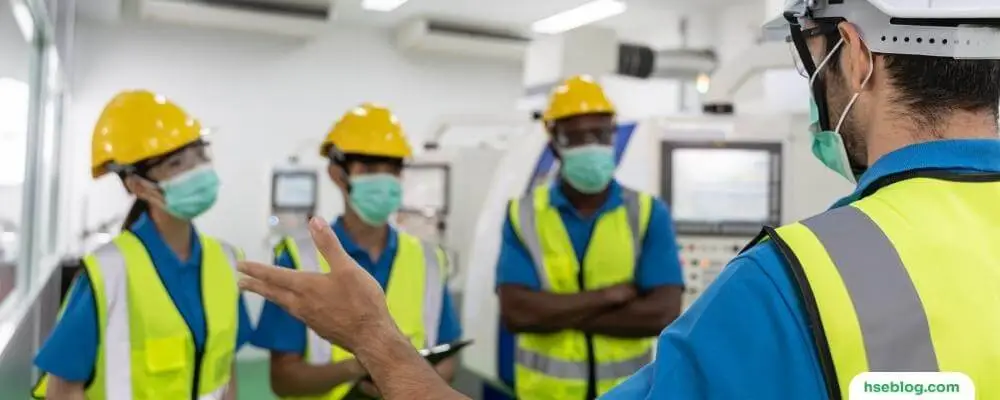In an increasingly complex and hazard-prone work environment, the importance of health and safety training cannot be overstated. Whether it’s about dealing with potentially harmful substances, operating heavy machinery, or simply navigating through day-to-day tasks in the office, there’s a great deal that employees need to be aware of to ensure a safe and healthy workspace.
This blog post delves into what health and safety training entails, its various types, and, crucially, why it is vital for any organization. We will discuss how such training helps minimize accidents and health risks and creates a more productive and positive work environment.
So, whether you’re a business owner looking to enhance your organization’s safety protocols, an HR professional tasked with employee training, or an employee curious about health and safety norms, this blog will provide valuable insights into the importance and execution of effective health and safety training. Join us as we explore this vital aspect of modern workplaces and discover how it can make a tangible difference in every employee’s professional life.
What’s Health and Safety Training?
Health and Safety training is a set of procedures, teachings, and methods designed to equip employees with the knowledge and skills to safely perform their job and maintain a safe work environment. This training aims to reduce workplace accidents and illnesses, ensuring workers can perform their roles effectively and safely.
Health and Safety training typically includes the following aspects:
- Education about hazards: This involves teaching employees about the potential hazards in their workplace. This could range from physical hazards, like machinery or hazardous substances, to issues like ergonomic hazards or workplace stress.
- Safe practices and procedures: Employees are taught the proper procedures and practices to handle various tasks in the workplace. This can involve safely operating machinery, handling hazardous materials, and maintaining proper ergonomics.
- Emergency procedures: Training typically includes information about what to do in an emergency. This can involve evacuation procedures, how to use fire safety equipment, and first aid procedures.
- Risk assessment: Employees are often taught how to identify potential risks in the workplace and take steps to mitigate these risks.
- Legislation and rights: Part of health and safety training often involves informing employees about their rights when it comes to health and safety, as well as informing them about the laws and regulations that their employer must abide by.
Health and Safety training aims to cultivate a safety-conscious culture within the workplace, ensuring that safety and health are primary considerations in all work activities. This training is essential for reducing accidents and illnesses and is typically required by law in many jurisdictions.

When Health and Safety Is Required?
Health and safety training is required in various situations:
- Newly employed: When new to a job, they need to understand the specific health and safety risks and procedures associated with their role. This might include training in equipment handling, company safety policies, or dealing with hazardous substances.
- Changing Roles or Equipment: If an employee’s role changes or new equipment or substances are introduced, additional training may be necessary to ensure the individual can perform their duties safely.
- Post-Accident: Additional health and safety training may be required to prevent similar incidents if a workplace accident occurs.
- Regular intervals: Regular refresher training courses are necessary to ensure that employees’ knowledge and skills are up-to-date. These can remind employees of safety procedures and update them on any health and safety regulations changes.
- Legislative Requirements: Certain industries and job roles require specific health and safety training by law. This could be anything from food hygiene certificates catering to first aid training for certain roles or specific training for working at heights or confined spaces.
- Risk Assessment Outcomes: The outcomes of risk assessments may identify the need for specific health and safety training. For example, if a risk assessment identifies employees at risk of exposure to hazardous substances, they must be trained to handle them safely.
Remember, the employer must ensure that their employees are sufficiently trained to perform their jobs safely and without health risks.

Why Is Health And Safety Training Important?
Health and safety training is of utmost importance in any workplace or environment, as it plays a critical role in protecting the well-being of employees, preventing accidents, and maintaining a safe working environment. Here are some key reasons why health and safety training is important:
1. Preventing Accidents and Occupational Illnesses
At the forefront of its benefits, health and safety training aims to prevent workplace incidents and job-related health issues. Employees well-versed in safety protocols and risk management procedures are significantly less likely to encounter accidents or develop work-induced illnesses. They understand the hazards associated with their roles and know how to minimize them effectively, making the workplace safer for everyone involved.
2. Meeting Legal and Regulatory Obligations
In many countries, stringent laws and regulations dictate the necessity for adequate health and safety training in the workplace. These standards are not optional, and failure to meet them can result in severe legal and financial repercussions. Comprehensive health and safety training ensures that organizations fully comply with these regulations, protecting them from potential lawsuits and fines.
3. Cultivating a Safety-First Culture
Regular health and safety training fosters a robust safety culture within an organization. When health and safety are consistently emphasized, employees become more safety-conscious and more proactive in maintaining a safe working environment. They look out for potential risks, follow safety guidelines diligently, and encourage their peers to do the same, contributing to a culture of collective responsibility for safety.
4. Enhancing Employee Morale and Productivity
Employees who feel secure in their work environment are generally happier, more productive, and more likely to stay with the company long-term. Health and safety training helps employees understand that their employer values their well-being, which can significantly boost morale and job satisfaction. Moreover, a safe work environment reduces downtime caused by accidents and illnesses, enhancing productivity and efficiency.
5. Promoting Effective Risk Management
Comprehensive health and safety training provides employees with the skills to identify and manage potential risks. Employees learn to anticipate hazards, respond effectively to incidents, and take swift action to mitigate harm. This proactive approach to risk management prevents accidents and helps the organization respond effectively when incidents occur.
6. Improving Company Reputation
A company prioritizes health and safety is seen as responsible and trustworthy, which can significantly improve its reputation among clients, customers, and potential employees. In contrast, companies with poor safety records may struggle to attract high-quality employees or retain customers.

7. Insurance Costs and Financial Ramifications
Regular health and safety training can reduce insurance premiums and other costs related to accidents and injuries at the workplace. Accidents can lead to high medical costs and even lawsuits, financially damaging a company. A safer workplace, brought about by comprehensive training, helps mitigate these costs.
8. Reducing Employee Turnover
Providing a safe working environment contributes to employee retention. Workers are likelier to stay with a company that prioritizes their health and safety, reducing recruitment and training costs associated with high staff turnover.
9. Enhancing Operational Efficiency
Trained employees know how to use machinery, equipment, and tools safely and efficiently, reducing the likelihood of damage and malfunctions. This, in turn, can improve operational efficiency and productivity.
10. Promoting Corporate Social Responsibility
Demonstrating a commitment to employee health and safety is a significant aspect of corporate social responsibility. Companies that emphasize safety are often viewed more favourably by the public, contributing positively to their brand image.
11. Facilitating Continuous Learning and Improvement
Health and safety training promotes a culture of continuous learning and improvement. The changing dynamics of the workplace, emerging technologies, and new industry standards all make it necessary for employees to regularly update their knowledge and skills.
12. Aiding in Emergency Preparedness
Safety training includes emergency response procedures, first aid, fire safety, and disaster response. This knowledge is crucial in ensuring employees are prepared to respond effectively in emergencies, thereby minimizing harm and damage.
13. Supporting Mental Well-being
Health and safety training is not just about physical safety. It also encompasses aspects of mental health and stress management. With this training, employees can better manage work-related stress and prevent burnout, contributing to a healthier, more balanced workforce.

Additional Reasons Why Health And Training Are Important?
- Building Trust: Companies that invest in health and safety training demonstrate that they value their employees’ well-being. This can build trust between employees and management, fostering a more cohesive and collaborative work environment.
- Accommodating Diverse Needs: Different roles and tasks may pose unique health and safety challenges in diverse workplaces. Tailored training can address these needs, ensuring all employees know and can manage the risks associated with their work regardless of their roles.
- Facilitating Risk Assessment: Regular training enables employees to better understand and assess the risks associated with their work. This awareness can help them make safer decisions and contribute to the overall risk management efforts of the organization.
- Supporting Innovation: New health and safety risks may emerge as businesses innovate and adopt new technologies or processes. Continuous training helps ensure employees are prepared to handle these new challenges, making innovation less risky and more productive.
- Encouraging Responsibility: Training helps employees understand that health and safety are not solely the responsibility of the management or a specific safety officer. Everyone has a role fostering a culture where everyone feels responsible for maintaining a safe work environment.
- Promoting Long-Term Employee Health: Over time, repeated exposure to certain workplace hazards can lead to chronic health issues. Regular health and safety training can equip employees with the knowledge to mitigate these risks, promoting their long-term health and well-being.
- Enhancing Business Competitiveness: Businesses that prioritize and excel in health and safety often have a competitive edge. They are more likely to attract and retain top talent, win contracts, and gain the confidence of investors and customers.

Different Types Of Health and Safety Training
Health and safety training can be classified into various types based on the specific areas they focus on. Here are some different types of health and safety training:
- General Safety Training: This includes training on the basic principles of health and safety, including identifying potential hazards, following correct procedures, and reporting safety concerns.
- First Aid Training: This trains employees to respond to various medical emergencies, from minor injuries to serious health crises.
- Fire Safety Training: This involves educating employees about fire prevention measures, the use of fire safety equipment, and evacuation procedures.
- Hazardous Materials Training: This training is relevant for workplaces dealing with potentially dangerous substances. It covers topics like safe handling, storage and disposal of hazardous materials, spill response, and use of personal protective equipment.
- Ergonomic Training: This type focuses on correct body mechanics, workstation setup, and injury prevention, particularly for employees who perform repetitive tasks or spend long hours at a desk.
- Equipment-Specific Safety Training: Employees who operate machinery or equipment receive training specific to each piece of equipment, including its safe operation, maintenance requirements, and problem identification.
- Construction Safety Training: This training is specific to construction sites and covers areas like fall protection, safe use of tools, and operating heavy machinery.
- Electrical Safety Training: This involves teaching employees about the risks associated with working with electricity and electrical equipment and how to minimize those risks.
- Chemical Safety Training: This training is provided to employees who handle chemicals. They are trained in safe handling, storage, disposal procedures, and emergency response in case of chemical spills or exposure.
- Food Safety Training: For those in the food industry, training on safe food handling, storage, and preparation practices is crucial to prevent foodborne illnesses.
- Noise and Vibration Training: This is essential for workers exposed to high noise levels and vibrations, often in industrial or construction settings. It covers the use of protective equipment and measures to mitigate risks.
- Mental Health Training: This increasingly recognized aspect of workplace health and safety aims to improve understanding and management of mental health issues.
- Manual Handling Training: For employees who perform lifting, carrying, or other forms of manual labour, this training focuses on correct techniques to minimize the risk of injury.
Remember that the specific training needs will vary depending on the nature of the work and the associated risks in each workplace. Conducting a thorough risk assessment to identify what type of training is necessary for your particular setting is crucial.
Conclusion
In conclusion, health and safety training is an essential aspect of any work environment that directly contributes to employees’ overall well-being and productivity. It equips individuals with the knowledge and skills necessary to identify, prevent, and respond to potential hazards in the workplace, thereby reducing incidents and accidents.
Beyond compliance with regulatory requirements, it fosters a culture of safety and health consciousness within an organization, leading to enhanced job satisfaction, improved morale, and a more successful and resilient organization. Therefore, the importance of comprehensive and regular health and safety training in today’s dynamic work environments simply cannot be overstated.

